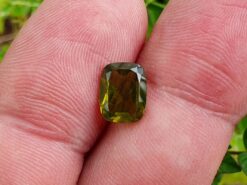Vesuvianite – Idocrase

Vesuvianite, also known as idocrase or californite. A green, brown, yellow, or blue silicate mineral.
Buy natural vesuvianite in our shop
The stone, also known as idocrase, is a green, brown, yellow, or blue silicate mineral. The stone occurs as tetragonal crystals in skarn deposits and limestones that have been subjected to contact metamorphism.
It was first discovered within included blocks or adjacent to lavas on Mount Vesuvius, hence its name. Attractive-looking crystals are sometimes cut as gemstones. Localities which have yielded fine crystallized specimens include Mount Vesuvius and the Ala Valley near Turin, Piedmont.
Identification
The specific gravity is 3.4 and the hardness 6 1⁄2. The name “vesuvianite” was given by A. G. Werner in 1795, because fine crystals of the mineral are found at Vesuvius, these are brown in color and occur in the ejected limestone blocks of Monte Somma.
Several other names were applied to this species, one of which, “idocrase” by R. J. Haiiy (1796), is now in common use.
Sources
A sky bluish variety known as cyprine has been reported from Franklin, New Jersey, USA and other locations. The blue is due to impurities of copper in a complex calcium aluminum sorosilicate. Californite is a name sometimes used for jade-like vesuvianite, also known as California jade, American jade or Vesuvianite jade.
Xanthite is a manganese rich variety. Wiluite is an optically positive variety from Wilui, Siberia. Idocrase is an older synonym sometimes used for gemstone-quality.
Cyprine
The fibrous copper-bearing variety cyprine was first observed by the author in 1905 in a small dump of unknown origin at the mouth of the Parker shaft. It was in bundles of slightly radiate needles scattered through a coarse-grained feldspathic pegmatite.
It is abundant in the specimens and is conspicuous, as its color is blue to blue-green. With it are manganophyllite, yellowish garnet, and native copper in threads and irregular fragments.
As the mineral was not at first recognized as cyprine but was thought to be a new species, material for analysis was separated by crushing and handpicking and careful rejection of all traces of the associated metallic, copper, as the mineral itself contains copper in combination. Analysis 1 is similar to that of cyprine from Tellemarken, Norway, but differs from it in details.
Vesuvianite meaning and healing properties benefits
The following section is pseudo scientific and based on cultural beliefs.
Psychologically, The stone meaning releases feelings of imprisonment and restraint, dissolves anger and alleviates fear and negativity. It helps to create a sense of inner security, opens the mind and stimulates inventiveness and the urge to discover, linking into creativity.
FAQ
What is vesuvianite used for?
This stone has been used to help release pent up anger in a gentle way that helps an individual find balance in their emotions. According to metaphysical beliefs, vesuvianite stone helps not only level out emotions, but can help us think level-headed by clearing negative or repetitive thoughts.
Where is vesuvianite found?
The crystal, also known as idocrase or californite is found in a number of locations in the world. It is known to form in skarn, silicate gangue or waste rock, and limestone deposits through the geological process of contact metamorphism. Some of the most notable gem-quality deposits come from Quebec, Canada and Mt. Vesuvius in Italy.
How do you use vesuvianite crystal?
While meditation, you can keep the stone near you or wear it, but to derive maximum benefit you should lie back down and place the stone on your chest so it can align with the heart chakra. You should try to cleanse your mind of negative thoughts to allow the crystal to bring positive changes in you.
Natural vesuvianite for sale in our gem shop
We make custom made vesuvianite jewelry as engagement rings, necklaces, stud earrings, bracelets, pendants… Please contact us for a quote.
















